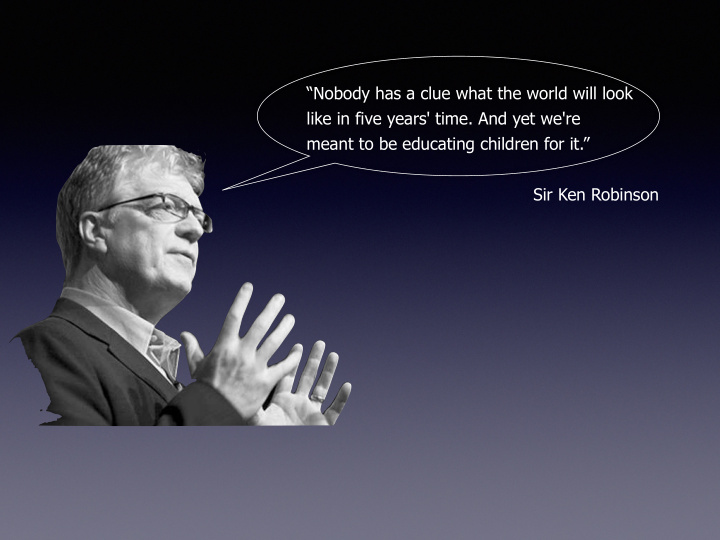



“Nobody has a clue what the world will look like in five years' time. And yet we're meant to be educating children for it.” Sir Ken Robinson
Goals For Presentation • Better understand difference between 20th & 21st century learning. • Better understand why important to strengthen 21st century learning in schools. • Better understand what Asian benchmark schools are doing. • Better understand current Gr. 8 21st century learning activity. • Receive invitations to more learning opportunities.
Sorting Activity In your envelope, there are ten examples of 20th C learning and ten examples of 21st C learning. Task Sort into appropriate columns.
Sorting Activity In your envelope, there are ten examples of 20th C learning and ten examples of 21st C learning. Task Sort into appropriate columns. We’ll check for understanding at end of presentation.
Changes in Teaching and Learning
Why?
World-Wide Interest
2012 IBM Global Chief Executive Study Key Employee Success Factors 75% Collaborative Communicative 67% Creative 61% 61% Flexible 54% Opportunity Seeking Analytical/Quantitative 50% 41% Technology Savvy 41% Global Oriented 25% Assertive Disruptive 16%
Desired Skills/Attitudes of SAS Graduate 41% Human Attributes 33% Habits of Mind 14% Global Mindedness 5% Hard Academic Skills 4% Technology
“We see a lot of undergrads at Stanford unable to collaborate and communicate. ” Susie Wise - K12 Lab Network Director Stanford d.school
So what is happening in schools?
NASA Longitudinal Creativity Study to select innovative engineers and scientists 98% Age 5 30% Age 10 Text 12% Age 15 2% Adult 0 25 50 75 100 George Land, 1968
Student Engagement 76% 61% 44% 500,000 participants - gr. 5-12
What’s ¡Happening ¡in ¡Asian ¡ Benchmark ¡Schools? International School Beijing Futures Academy Project Based Learning
What’s ¡Happening ¡in ¡Asian ¡ Benchmark ¡Schools? ISB Vision 2020 International School Bangkok
What’s ¡Happening ¡in ¡Asian ¡ Benchmark ¡Schools? Jakarta JIS Website: International School We must therefore convert our schools, perhaps fundamentally, to allow for new and appropriate methodologies of learning.
What’s ¡Happening ¡in ¡Asian ¡ Benchmark ¡Schools? Design Thinking Singapore American School R & D Learning for the Future
What’s ¡Happening ¡in ¡Asian ¡ Benchmark ¡Schools? Nanjing International School Design Thinking American School In Japan
What’s ¡Happening ¡in ¡ ¡ President ¡Obama’s ¡School?
What’s ¡Happening ¡in ¡ ¡ President ¡Obama’s ¡School? Xizhou is our Microcampus location.
The � Big Shifts � … and Schools of the Future Patrick F. Bassett, NAIS President bassett@nais.org
Are We Ready for the Big Shifts? ! ! ! (cf. MacArthur Foundation, 21 st . C. Learning) ! " The Big Shifts " ! Knowing…………….. Doing ! ! Teacher-centered…… Student-centered ! ! The Individual………. The Team ! ! Consumption of Info….Construction of Meaning ! ! Schools………………..Networks (online peers & experts) ! ! Single Sourcing……… Crowd Sourcing ! --------------------------------------------------------------------- ! ! High Stakes Testing….. High Value Demonstrations !
My Research This Year: Visits to 21st century learning schools in California and Atlanta EARCOS Leadership Conference Strategic Planning Curriculum Committee
My Research This Year: Visits to 21st century learning schools in California and Atlanta EARCOS Leadership Conference Strategic Planning Curriculum Committee 2 Types of Learning Stand Out
Design Thinking & Project-Based Learning
Design Thinking
Design Thinking Solving Problems
Design Thinking Process
Marshmallow Challenge Instructions 1. Build the Tallest Freestanding Structure: The winning team is the one that has the tallest structure measured from the table top surface to the top of the marshmallow. That means the structure cannot be suspended from a higher structure, like a chair, ceiling or chandelier. 2. The Entire Marshmallow Must be on Top: The entire marshmallow needs to be on the top of the structure. Cutting or eating part of the marshmallow disqualifies the team. 3. Use as Much or as Little of the Kit: The team can use as many or as few of the 20 spaghetti sticks, as much or as little of the string or tape. The team cannot use the paper bag as part of their structure. 4. Break up the Spaghetti, String or Tape: Teams are free to break the spaghetti, cut up the tape and string to create new structures. 5. The Challenge Lasts 18 minutes : Teams cannot hold on to the structure when the time runs out. Those touching or supporting the structure at the end of the exercise will be disqualified.
DT “Design A Wallet” in gr. 8 Advisory. DT Exploratory class.
Project Based Learning Solve Questions, Problems, Challenges
Project Based Learning Explained
In Project Based Learning (PBL), students go through an extended process of inquiry in response to a complex question, problem, or challenge. While allowing for some degree of student "voice and choice," rigorous projects are carefully planned, managed, and assessed to help students learn key academic content, practice 21st Century Skills (such as collaboration, communication & critical thinking), and create high-quality, authentic products & presentations.
Gr. 8 Integrated Project - Global Issues Summit
Sorting Activity In your envelope, there are ten examples of 20th C learning and ten examples of 21st C learning. Task Sort into appropriate columns.
What can I do at home to stimulate my child’s creative and innovative thinking?
MS Counselor Coffee Thurs. Feb. 27 10:00 in HS A103 Topic: Parent Partnerships
New Chinese Program Wednesday, March 5 (Chinese) Wednesday, March 12 (English) 9:00 - 10:00 in LMC Presenter: Dr. Suyi Wang
Science Curriculum Presentation Thursday, March 6 8:15 - 9:00 in TBD Topic: Science in the 21st Century
Questions For Follow Up? Please put on note card.
Recommend
More recommend